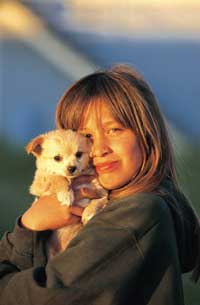Feeding Guide
All the pet food on our site will provide your dog with all the goodness needed to maintain well being and good health. When changing from another brand we recommend that you do so over a few days by mixing it in with the old food and gradually increasing the amounts. This will help prevent any stomach upset. Changing varieties across the range should not normally cause any problems.
Making a start
How much to feed is always difficult, as dogs vary much more than humans with their requirements. Think of the contrast between a lively border collie and a sedentary Pyreneen Mountain Dog, or an outdoor and indoor environment - feeding is an imprecise science!
The feeding guide you find on the back of a bag is just that - a guide - AND IT is always best to let your dog's condition be the main guide to feeding amounts - if weight is maintained and body and coat condition excellent then you've got it about right!
At least one premium brand quotes 10g/kg body weight as a a feeding guide. I've seen dogs fed at this level with no supplementation (and done it myself) and they seem a bit too thin (which can bring its own health problems.)
A good average guide for an adult dog is 12-15g for each kilo of body weight, and always feed the minimum that will maintain body weight and condition. For an overweight dog, feed to the weight they should be, not the weight they currently are.
A good way of determining whether your dog is fit is to look down on him from above; you should be able to see a waistline, unless he is a very longhaired breed in which case you could try feeling for the waistline.
However, if you can easily see his ribs then your dog is too thin, unless he comes from a breed that is usually like that such as a whippet or greyhound.
Working and active breeds will benefit from being fed a working dog food as it contains the calories and carbohydrates they require to maintain their correct weight. It is, of course, prudent to have your dog checked over and weighed regularly by your vet.
As long as your dog is lively and healthy he should always have a good appetite. If one or two meals are missed ever it should not cause concern. However, if your dog usually has a good appetite and suddenly stops eating, or has symptoms such as diarrhoea, contact your vet for advice.
Fussy Dogs
Dogs need a good routine and should be fed the same type of food at every meal. If they are given lots of different things to eat they can suffer from stomach upsets and become picky with what they will eat. It is best to put their food down for them without any fuss and to leave them to calmly eat it.
If after around 15 minutes they have eaten most or all of the food they can then be praised and petted, anything left over should be quietly thrown away. It is not good practise to fuss over dogs at meal times as they can easily learn that not eating is a good way of getting attention.
Neutering and food
It is widely believed that neutering makes dogs fat. Although this is not strictly true neutered dogs often need fewer calories. After your dog is neutered keep an eye on his waistline to see if there are any changes and if necessary reduce the amount you feed him. If he looks like he might be getting too heavy try him on a Senior/Light to reduce his calorie intake without reducing the nutrients he requires.
Older dogs and their food
As dogs get older their nutritional needs change. They need a more digestible food lower in calories. You will need to watch your dog’s weight carefully to prevent middle age spread! Older dogs, like us humans, can suffer from joint stiffness and can be prone to arthritis. As well as containing less calories and being made with easily digestible fish for its protein source our Senior/Light food contains the supplements Glucosamine, Chondroiton and MSM to reduce joint wear, fight arthritis and elevate joint pain and stiffness.



